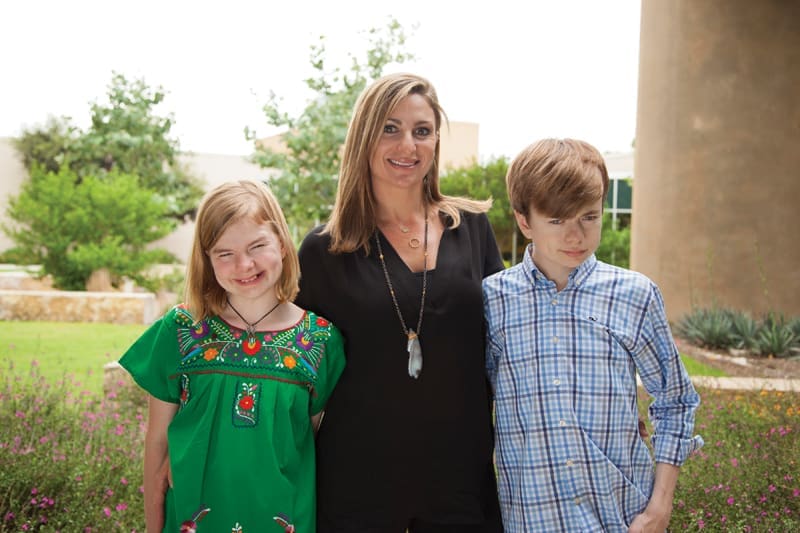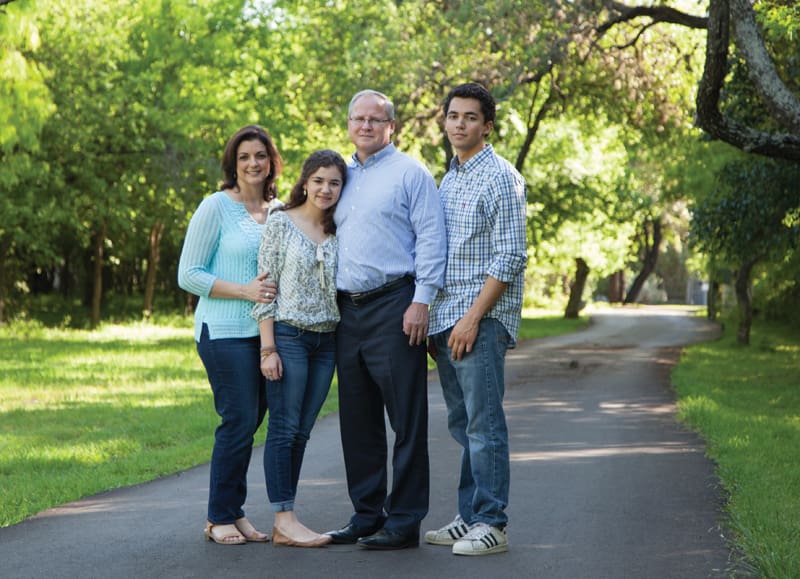The last thing any parent wants to hear is that there’s something wrong with their child. And yet, it happens, and the “wrong” is sometimes very serious. It’s heartbreaking and life changing. The three families profiled here have learned not only to live with it, but have been inspired by their family situations to reach out and help others. These are stories of insight, generosity and vision for a better future.
Kim Azar greets me warmly as I arrive at her house in a quiet residential mid-town neighborhood. She has just come back home herself after picking up her kids from school and is preparing a snack for her 11-year-old daughter, Ava. I am introduced to both Ava and her older brother, John Ben, who soon retreats into another room to focus on a video game.
“We had quite an exciting week last week,” says the mom almost light-heartedly; “we spent five days in the hospital.” Without telling her, John Ben had stopped taking his medications and became very ill. He hates the side effects, she explains. “The meds make him throw up, and this one (she points to a bottle) has an odor that comes out through the skin. It smells like rotten eggs.” Though the hospital experience was unsettling, Azar believes that it scared her son enough to make him think twice before doing anything like that again.
Both children were born with a rare genetic condition called cystinosis — so rare, in fact, that only about 400 people in the U.S. have it and only about 2,000 worldwide. It’s caused by a small genetic mistake that impairs the body’s ability to produce cystinosin, an important enzyme that helps cells expel the amino acid cystine, which we all have in our bodies. Without this crucial enzyme, cystine crystallizes in the cells and slowly strangles the functioning of kidneys, eyes, muscles and other organs. It happens only when both parents are carriers of the genetic defect that causes the disease.
Azar and her former husband, John Shepperd, first noticed that something was wrong when their son was about 15 months old. He would wake up at night crying and thirsty. The pediatrician shrugged it off. Then the family took a skiing vacation together during which the baby got much worse. He went silent, his head became wobbly and he only wanted water that he would later vomit. “It was terrifying,” recalls Azar. Back in San Antonio, they went straight to the hospital, where the child was stabilized, but the doctors could not figure out what he had. A nurse finally told the parents to take John Ben to Houston’s Texas Children’s Hospital, where the diagnosis was finally made. “She saved his life,” notes Azar gratefully.
To keep their kid alive, the parents had to administer the drug Cystagon every six hours through a tube inserted in his abdomen, plus a slew of other meds to help with nausea and prevent organ damage. When Ava was born with the same condition a few years later, the treatment was started when she was just eight weeks old.
“I don’t know how I did it all,” admits Azar. “That was our life. You are a mom, you love them. You do what you have to do.” Though she has struggled emotionally, she now believes that God gave her “these children because I can do this. God doesn’t give us more than what we can handle.”
While the family was coping with the situation, Azar’s father, Richard Azar, received a routine call one day from the Texas Biomedical Research Institute thanking him for his financial contribution. His wife, Dianne, had been a member of the institute’s support organization for years, and the couple had made regular donations. He engaged the caller in conversation, explained the health problems of his grandkids and asked if the genetics department at the research institution could help. Before long an unexpected partnership was born between the Texas Biomed scientists and the Azar family. A gift of $2.5 million from the elder Azars and their friends enabled geneticist John Blangero and his team to undertake a study of other genes that may influence the pathobiological pathway of the disease. The hope was to discover new ways to halt the progress of cystinosis. Though Azar admits that she doesn’t quite understand what the scientists have been doing, she admiringly reports that the success of the project has since generated $40 million in grants for studies all over the world. The Azar grandkids may not benefit from the research in the near future, but the long-term promise is far-reaching.
Today, both John Ben and Ava look healthy, yet the multiple-drug regimens continue. Azar puts a handful of pills on the table to show me what her children must take twice a day. Divorced and working as a Realtor, the brave mom strives to make life as normal as possible while teaching her kids to be independent. ”We run the cystinosis. This disease does not run us,” she says firmly.
Profoundly Grateful
Stephanie Edlund was 4 years old in 2006 when she started complaining of leg pain. One day her mother, Terri Edlund, got a call from the Mother’s Day Out program that Stephanie was attending at the time. You have to pick her up, they said, something is wrong with Stephanie — she fell down out of the blue, without tripping or being pushed by anyone. Worried, the Edlunds took their little girl to Methodist Hospital for tests, including blood work and X-rays. That was at 3 p.m. on March 10. At 4:30, the hospital called, instructing the family to take their daughter immediately to the Christus Santa Rosa Children’s Hospital ER, where she immediately received a blood transfusion.
This was the beginning of their painful two and a half-year ordeal that saw Stephanie diagnosed with acute lymphoblastic leukemia and treated with repeated cycles of chemotherapy. Terri stayed with her daughter through all the hospitalizations that followed. Eventually, the little girl was put on maintenance therapy, which Terri describes as “a walk in the park compared to the first 10 months of harsh chemo.” Her daughter’s hair grew back, and she was well enough to go to school. Still, the parents worried about infections that could lead to life-threatening sepsis, given that the girl’s immune system had been weakened by chemotherapy.
“It was very difficult,” says Terri now, her daughter sitting next to her on the couch in the family’s home. “We had a busy life, the calendar was packed, and then when this happened, you throw the calendar out of the window, and everything stops. It’s a humbling experience being in that hospital and watching all these kids with leukemia and having no control over anything. You are at the mercy of the medical personnel.”
That unsettling experience has instilled in both Terri and her husband, Steve, a profound appreciation of the medical profession and the desire to help all who work to improve the lives of patients. They actively support the Leukemia and Lymphoma Society, the Children’s Hospital Oncology Unit and the Greehey Children’s Cancer Research Institute (GCCRI) at UTHSC. It was the doctors from the medical school who saved the life of their daughter at Christus Santa Rosa, now the Children’s Hospital of San Antonio. (The hospital has a different care arrangement at present.) Since 2008, the spouses have co-chaired GCCRI’s Ambassadors’ Circle that raises funds for the institution, and in 2014 they established an endowment named for their daughter to support the appointment of a faculty member pursuing a career in pediatric cancers. In addition, Steve is a member of the UTHSC President’s Development Board, and Terri joined the Family Advisory Board at the Children’s Hospital.
“We feel obligated to them (the UTHSC doctors) and to the Children’s Hospital,” notes Terri. “When they ask us to do something, we always say ‘yes.’ We benefited from the knowledge and the established protocols of treatment. Our child survived! We are so profoundly grateful.” She leans forward for emphasis while saying this, her face lit up with emotion.
For Stephanie, the years of her illness are a blurred memory of spending time in the hospital. Despite dealing with some post-treatment side effects — “There are still things I can’t do,” she admits — she is today a pretty, active girl who plays soccer and basketball and hopes to “do something in the medical field” when she grows up.
As for Terri, she is a changed person. “Your perspective on life changes completely. Things that used to look big and important no longer matter. You learn what’s really important. Going to sleep at the end of the day knowing we are all here and all OK is awesome.”
What advice would she give a parent going through the agony that she and Steve endured?
“The main advice: Handle things one day at the time. Be there for your child today, then deal with tomorrow, tomorrow.”
A Theme Park for the Disabled and Everyone Else Located in Northeast San Antonio, Morgan’s Wonderland is a beautiful theme park that invites children of all ages and abilities to enjoy recreational activities, including rides, fishing, picnics and puppet shows, and in the near future, a splash water park. But there’s something unique about it. All equipment is designed with wheelchair accessibility in mind, and the entire complex is user-friendly for kids — and adults — with special needs. The first of its kind in the U.S., the park is the result of Gordon and Maggie Hartman’s desire to help the special needs community and facilitate interaction between that population and the general public.
Located in Northeast San Antonio, Morgan’s Wonderland is a beautiful theme park that invites children of all ages and abilities to enjoy recreational activities, including rides, fishing, picnics and puppet shows, and in the near future, a splash water park. But there’s something unique about it. All equipment is designed with wheelchair accessibility in mind, and the entire complex is user-friendly for kids — and adults — with special needs. The first of its kind in the U.S., the park is the result of Gordon and Maggie Hartman’s desire to help the special needs community and facilitate interaction between that population and the general public.
The Hartmans’ only child, daughter Morgan, was born with both physical and cognitive special needs. Mom Maggie says they first began to worry when the little girl had not yet begun to speak by the age of 2. Tests, doctors’ visits and various therapies followed, and some of them helped, but Morgan never received an actual diagnosis. After the age of 10, the parents gave up seeking a definitive answer and accepted the general description of their child’s condition as a multi-system disorder.
“It’s not a big deal,” says Gordon today, as we sit in a meeting room on the park’s premises. “Morgan is Morgan. We know what her issues are. A label is immaterial, in fact, may be a disadvantage.”
Nevertheless, Maggie confesses to having had a hard time dealing with the situation while contemplating the challenges her daughter would have to face. “It hit me the hardest when Morgan was 12,” she says. “I had to grieve the loss of ‘my normal child’ before I could accept Morgan as she was. I cried for two weeks. This turned things around for me. I looked at Morgan and saw the amazing person that she really was.”
A successful homebuilder, Gordon Hartman sold his companies in 2005 to found the Gordon Hartman Family Foundation, whose mission is to support agencies that provide services to the disabled and their caregivers. Most families do not have the resources that he and Maggie have, he points out, and that’s where the foundation comes in. But what spurred the idea of an outdoor recreational facility was a specific incident during a family vacation. The Hartmans were enjoying the hotel’s pool when Morgan tried to join three other kids playing ball in the water. She edged her way to where she could hit the ball, but the other children just grabbed their ball and left. “It seemed to us that there ought to be places for inclusive play where what we had experienced would not happen,” says Gordon.
The Hartmans soon learned that few recreational places offered any special-needs equipment, let alone areas for inclusive play. That’s when their novel idea was born: a playground not only to serve the disabled but to integrate the special needs kids with other youngsters within the community. “We wanted to take down those barriers,” notes Gordon. Being a man of action, he proceeded to create a separate nonprofit to raise funds for the project, donating $1 million himself. “There was such a desire for something like this to happen,” he recalls. “People come from all over the world to enjoy the park, and entrance is always free for all disabled individuals.”
Today, at 22, Morgan lives semi-independently in a group home and attends the Academy at Morgan’s Wonderland, which opened in 2011 for special needs students like herself. In the years since its opening, the park has become the centerpiece of Wonderland, Texas, which, in addition to the school, includes the Children’s Rehabilitation Institute of TeletonUSA and STRAPS, a program for physically disabled athletes of all ages.
Before leaving Wonderland, I linger around a little longer to watch the Hartman family shoot a promotional video. Morgan is the star, shown fishing with her dad, while Mom delivers a friendly promotional pitch. There’s lot of happy laughter and easy affection between father and daughter as they catch and release the fish. And I am reminded of something Gordon said earlier during our conversation. “She is a blessing to us. Morgan puts her arm around me all the time. How many 22-year-olds would put their arms around their dad? Morgan still sees us as cool.”
By Jasmina Wellinghoff
Photography by Elizabeth Warburton
The post Upfront: Family Pain Gives Rise To A Greater Good appeared first on San Antonio Woman Magazine.





